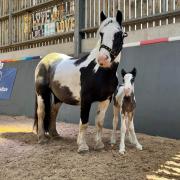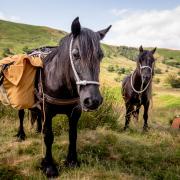If you spot a violin hanging on a washing line, the chances are it belongs to Kendal instrument maker Carol Klemperer. Sue Riley reports, PHOTOGRAPHY: DARREN ANDREWS
On the wall of Carol Klemperer’s workshop at her Kendal home is a posterof a Stradivarius Messiah violin which was made in 1716. It is a constant source of inspiration.
‘It’s my dream violin,’ she says. ‘But then I think it’s everyone’s dream violin.’
Carol started making instruments because, as a professional musician, she wanted to play an amazing violin. But although she has worked on hundreds of stringed instruments during her career she has only made seven violins from scratch. Each one - apart from her first which she uses to teach music in schools - has been sold. She fondly refers to it as ‘anold friend, full of mistakes and full of good work.’
It was only when she moved to the Lake District and became a mother that she decided to try to fulfil her ambition. She finished her first in 1989, the year her third and last child was born, and has gone onto hone her skills at workshops led by top makers such as Juliet Barker inCambridgeshire, Malcolm Siddell in Wales and Kevin Wilkes at Leeds College of Music.
She keeps detailed files with lots of notes and photographs, including many of violins, violas and cellos drying on her washing line. ‘You need sunshine to harden and mellow the varnish, that’s why Italy is good,’ she says. ‘It’s not a good idea to leave them on the line here and go off and do your shopping!’
She remains modest about her violins. ‘I think it’s 90 per cent the player, I know players who could make a wet paper bag sound exquisite,’ she says. Yet her instruments, each better than the last, are a labour of love for the scientist and musician who insists that the two disciplines work hand in hand.
In her newly downsized workshop, she buys well-seasoned pine and maple from specialist suppliers. Then using her selection of finely-honed tools (including ones specially made for her such as a 1cm wide plane) she sets about making the violin, shaping and carving the wood by hand and inlaying it with ebony and white wood, before adding the ‘furniture’including the bridge and strings.
Yet for all the artistry, Carol, 54, is pragmatic saying the violin is simply atool. ‘It has to conform to certain measurements, it’s a balance of ratios and specific measurements, within that you have artistic licence. There’s nothing extraordinarily difficult, it’s just patience, skill and knowledge, there’s no mystique to it.
Every one I make is better than the last one which is sad as I am not going to have time to get to my peak. You know you can make a better one, the ever elusive masterpiece, that drives you,’ she says. ‘It’s about using the best (materials) I can, finding the best quality, doing things slowly and making everything count from the moment you get your first piece of wood. Fine materials will help but at the end of the day the violin is a tool.’
She says she could make an instrument in a few weeks if she worked on it full time but as she fits it around her job as curator of Natural History at Kendal Museum, professional musician and teaching, the instruments often take months if not years to complete. ‘I know a bit about the musicworld and it’s very hard to make your living as a musician. If you want to be a professional violin maker you might as well go away and starve slowly. We live in a commercial world. I have a day job which is also my passion.’
Although she played violin as a child – she is a relation of one of the 20thCentury’s most famous conductors , Otto Klemperer, but declines to talk about it saying
‘You make your own way, you can’t trade on that heritage’ – she concentrated on the sciences at school and only took up music again when she went to university in Sheffield to study zoology. ‘I always found it an inspiration when people were bridging the gap between science and the arts.’ On her very first day at university she met John Davies, her future husband. They have three adult children who play cello, viola and violin – all instruments made by Carol.
A few years ago she and her husband used all their savings to buy a violin made by Bert Smith of Coniston.
‘It’s my pride and joy,’ said Carol. ‘I have always wanted a beautiful violin of my own. When I was given the opportunity to buy the violin we used everything we had. it was not a big amount but it was to us. It’s a very powerful, soloistic instrument. I felt I was not good enough for a long time, it shows every fault because it’s such a perfect instrument. I had a bit of a love-hate relationship but in recent years I have come to love it.’
She still plays professionally, is in a string quartet and also performs with Leeds Baroque Orchestra. Last Easter she performed a Jewish lament from memory to open the Kendal Passion Play at Kendal Castle. She said playing her solo on her Bert Smith violin (made in 1969) was ‘wonderful’.
‘In recent years I have become more comfortable with playing, my nerves have completely gone. As you get older you have less to prove.’ And as she says: ‘The violin is in my blood.’ Hardly surprising when you are related to one of the world’s greatest conducters.
More about Bert
Bert Smith, pictured above, was self-taught but that didn’t stop the Coniston craftsman becoming highly regarded as an instrument maker. He once made a violin for Yehudi Menuhin and the two men appeared together in a BBC documentary in the 60s. There is a case devoted to his work at the Ruskin Museum in Coniston.
It’s rare for his instruments to come on the market but one sold at Bonhams in 2009 for over �1,000.


























